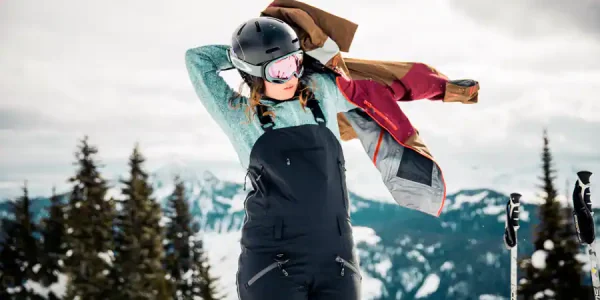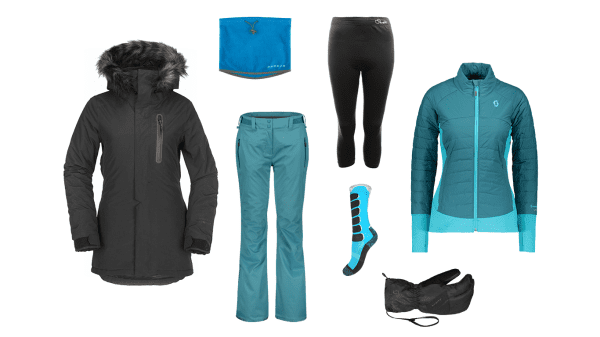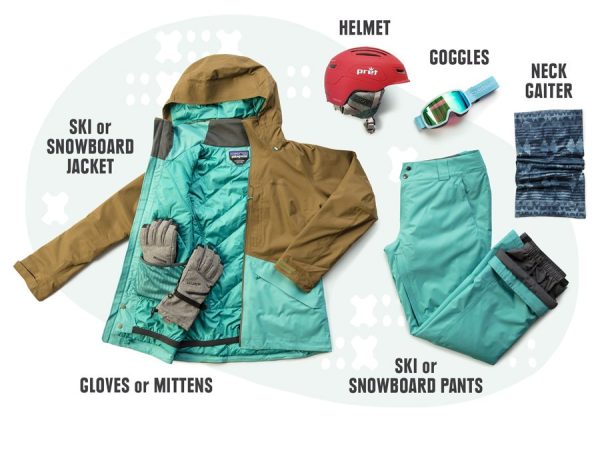
Skiing is a really exciting sport that not only gets your adrenaline pumping, but also gives you a chance to show off your personal style while staying warm and comfortable on the slopes. It is important to pick the right clothes when you go skiing, whether you’re a pro or trying it out for the first time. In this blogpost, we’ll talk about all the important things you should know about what to wear skiing, from base layers to outerwear, so you can stay stylish and warm while enjoying the snowy slopes.
What to Wear Skiing
1. Base Layers:
Your first line of protection against the cold is your base layer. Select breathable, moisture-wicking materials like synthetic mixes or merino wool. By drawing perspiration from your skin, these materials will keep you dry and spare you from that awful clammy sensation. Cotton holds onto moisture and can make you feel cold.

2. Insulating Layers:
To keep warm in below-freezing weather, pile on layers of insulating clothing. A down vest or fleece jacket are excellent mid-layers. Selecting compressible, light-weight materials that offer warmth without adding bulk and facilitate free movement on the slopes is the secret.
3. Outerwear:
Your protection from moisture, snow, and wind is your outer layer. To ward against the weather, get a windproof and waterproof ski jacket and trousers with sealed seams. See for features like powder skirts, pit zips for extra ventilation, and movable cuffs. Bright hues or striking designs improve visibility on the mountain in addition to looking good.
4. Accessories:
Never undervalue the role accessories play in your skiing outfit. Not negotiable for safety, a helmet guards against head injuries in the event of falls or crashes. Clear vision and eye defense against sun, wind, and snow glare require sunglasses with UV protection and anti-fog lenses. For warmth of the head and ears, don’t forget a thick beanie or balaclava, and for protection from the cold, waterproof gloves or mittens.
5. Socks and Footwear:
For warm, dry feet inside your boots, choose cushioned, moisture-wicking ski socks. Steer clear of big, uncomfortable socks that can impede circulation. Invest on well fitting ski boots to give your ankle support and exact control over your skis. Avert excruciating blisters by breaking them in before hitting the slopes.

6. Layering Technique:
The key to staying warm and comfortable while skiing is the layering technique. Start with your base layer, followed by insulating layers, and finish with your waterproof outerwear. This allows you to adjust your clothing according to the changing weather conditions and your activity level throughout the day.
7. Don’t Forget Sun Protection:
High elevations might get strong sunbeams even on cloudy days. Slather exposed skin—especially your face, neck, and ears—with a high SPF sunscreen. For extra defense against sunlight and sunburn, choose a helmet with an integrated visor or a brimmed cap.
8. Consider the Weather Condition:
Look at the weather before you go and dress appropriately. On colder days, layer more; on warmer ones, dress lighter. In the mountains, be ready for unexpected weather changes and always pack additional clothing in your backpack.
Frequently Asked Questions About What to Wear Skiing
Q1: What should I wear skiing if I’m a beginner?
As a beginner, it’s important to prioritize comfort and warmth. Start with a moisture-wicking base layer, followed by insulating layers like a fleece jacket or down vest. Opt for waterproof ski pants and jacket to keep dry. Don’t forget essential accessories like a helmet, goggles, gloves, and warm socks.
Q2: How should I dress for skiing in different weather conditions?
Dressing for skiing varies depending on the weather. On cold days, layer up with thicker base and insulating layers. On warmer days, opt for lighter clothing and consider wearing shell layers for protection against wind and moisture. Always check the weather forecast before heading out and adjust your clothing accordingly.
Q3: Can I wear jeans for skiing?
It’s not recommended to wear jeans for skiing as denim doesn’t provide adequate warmth or moisture-wicking properties. Instead, opt for moisture-wicking base layers and waterproof ski pants for better comfort and performance on the slopes.
Q4: What’s the best type of socks to wear skiing?
The best socks for skiing are moisture-wicking, cushioned ski socks made from materials like merino wool or synthetic blends. These socks provide warmth, comfort, and moisture management, helping to keep your feet dry and blister-free inside your ski boots.
Q5: Do I need to wear a helmet while skiing?
Yes, wearing a helmet while skiing is highly recommended for safety. Helmets provide essential protection against head injuries in case of falls or collisions. Make sure your helmet fits properly and meets safety standards for skiing and snowboarding.
Q6: How can I stay warm while skiing without adding bulk?
Layering is the key to staying warm without adding bulk. Start with a moisture-wicking base layer, add insulating layers like fleece or down, and finish with a waterproof outer layer. Look for lightweight, compressible materials that provide warmth without restricting movement.
Q7: Are there any specific clothing considerations for skiing in extreme cold?
When skiing in extreme cold temperatures, it’s crucial to layer up with extra insulating garments and accessories like a balaclava or face mask to protect exposed skin. Invest in high-quality, insulated outerwear with features like adjustable cuffs and a powder skirt to keep out cold air and snow.
Q8: Can I wear my regular winter coat for skiing?
While you can wear a regular winter coat for skiing, it’s not ideal. Ski-specific jackets are designed with features like waterproofing, breathability, and insulation, which are essential for comfort and performance on the slopes. Invest in a proper ski jacket for optimal warmth and protection.
Wrap Up
Ultimately, a good day on the slopes depends on wearing the appropriate clothing, which should combine comfort, functionality, and style. To stay warm and dry in any weather conditions, make sure to layer appropriately. Start with moisture-wicking base layers, add insulating pieces, and top it off with waterproof outerwear. Make sure you remember to wear gloves, eyewear, and the right footwear to complete your skiing outfit. This will help you look stylish and feel confident while you’re on the mountain. Once you have the right gear, you’ll be all set to hit the slopes and have an amazing skiing adventure while staying warm and stylish.

Leave a Reply